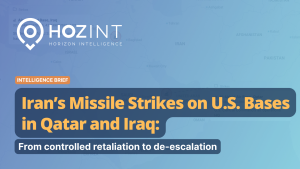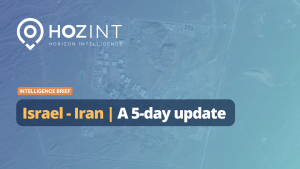Key Points:
-
Operation Spider Web marks Ukraine’s most damaging drone strike of the war, targeting strategic Russian airbases and long-range bombers with a reported USD 7 billion in damage.
-
The operation showcased exceptional tactical deception, including months-long preparations and covert drone deployment inside Russian territory.
-
It signals a shift in Ukraine’s offensive doctrine, extending operational reach far into Russia’s interior and revealing major gaps in Russian airbase security.
-
The strike occurred just days before Istanbul peace talks, possibly aimed at influencing negotiation dynamics.
-
Strategic implications include potential Russian escalation, renewed doctrinal focus on base security, and increased use of asymmetric tactics by Ukraine.
Event Description
What: Ukraine launched a complex, multi-phased drone operation—codenamed “Operation Spider Web”—targeting strategic Russian military airbases in the Irkutsk and Murmansk regions. The operation reportedly damaged or destroyed several Tu-95 strategic bombers, aircraft valued collectively at USD 7 billion.
Who: The Security Service of Ukraine (SBU) and the Ukrainian military’s drone operations unit executed the strike. President Volodymyr Zelenskyy reportedly oversaw the operation personally.
Where: The strikes hit airbases in Olenegorsk (Murmansk Oblast) and Belaya (Irkutsk Oblast)—over 2,500 miles from Ukrainian territory.
When: The drone strikes were executed on or around June 1st, 2025, just before peace negotiations scheduled in Istanbul on June 2nd.
Why: Ukraine aimed to degrade Russian strategic strike capabilities, disrupt cruise missile deployment platforms, and assert retaliatory capability deep inside Russian territory.
How: Over 117 quadcopter drones were pre-deployed inside Russian territory, hidden under the roofs of wooden sheds mounted on trucks. These drones were remotely activated, launched from within Russian military airbase perimeters, indicating extensive prior infiltration and coordination across multiple time zones.
Analysis
This operation reflects a major escalation in Ukraine’s operational doctrine. Rather than conventional artillery or near-border drone strikes, Kyiv has projected power deep into Russia’s strategic interior. The use of disguised mobile launch platforms demonstrates a mastery of deception, long-term planning, and precision targeting. This aligns with Ukraine’s broader shift toward asymmetric, high-impact strikes, compensating for its inferior conventional firepower.
Russian defence systems failed to detect and neutralise drone platforms deployed inside their own high-security zones, suggesting critical gaps in counterintelligence, base perimeter security, and anti-drone defences. The fact that sheds with concealed drones were parked near Tu-95 bombers implies a severe lapse in surveillance protocols, potentially prompting a doctrinal reassessment within Russia’s Aerospace Forces (VKS).
The operation’s timing—on the eve of scheduled Istanbul negotiations—likely served both strategic and political objectives. By demonstrating Ukraine’s operational reach, Kyiv increases its leverage at the negotiating table. It signals to both Russia and international mediators that Ukraine remains militarily potent and can strike core Russian assets at will.
The release of video footage showing burning Russian bombers and audio of Russian servicemen expressing panic contributes to Ukraine’s information warfare campaign. It demoralises Russian personnel while rallying domestic and Western support for continued military assistance.
Implications for Aviation Security
Operation Spider Web also raises significant concerns for global aviation security, especially for military and dual-use airbases. The ability to deploy remotely launched drones from disguised mobile units parked near runways exposes vulnerabilities not just in Russian territory but potentially in other high-value aviation environments worldwide. Civil and military airports—especially those in conflict-adjacent regions—will need to reassess their perimeter surveillance, mobile platform screening, and low-altitude drone detection systems. Moreover, it demonstrates the growing potential for drone-based attacks to bypass traditional radar and missile defence systems by exploiting soft, internal access points. For civil aviation, particularly in volatile regions, this increases the urgency to integrate counter-drone protocols into security frameworks and contingency planning.
Forecast
1. Russian Retaliation and Doctrinal Shift
- Expect a Russian military reprisal, likely in the form of:
-
Intensified missile strikes on Ukrainian infrastructure.
-
Counter-drone and counter-sabotage operations inside Ukraine.
-
Expanded internal surveillance and counterintelligence purges.
2. Hardening of Russian Bases
- Russia is likely to increase fortification of its strategic airbases, particularly those within drone range from smuggled platforms. This may include:
-
Increased patrols.
-
Electronic warfare (EW) deployments.
-
Structural overhauls to parking and storage protocols for high-value aircraft.
3. Ukrainian Drone Doctrine Will Expand
- This success will likely embolden Ukraine to replicate or escalate such operations, possibly extending to naval or energy infrastructure. Its burgeoning domestic drone industry will also attract more Western investment and technical cooperation.
4. Impact on Negotiations
- This could:
-
Harden Russia’s stance out of humiliation or political pressure.
-
Strengthen Ukraine’s negotiating hand by showing it still holds escalation tools.
-
Motivate mediators (e.g., Turkey) to press for ceasefires more urgently.
Conclusion
Operation Spider Web is arguably the most complex and far-reaching special operation Ukraine has executed since the war began in 2022. It reflects a strategic adaptation to asymmetric warfare, shrewd political timing, and a robust domestic intelligence apparatus capable of operating deep behind enemy lines. While the immediate battlefield impact may be limited to a handful of bombers, the psychological, strategic, and diplomatic repercussions are profound. This operation sets a new precedent for warfare in the 21st century—where long-range precision can be launched from hidden domestic platforms deep inside enemy territory.




